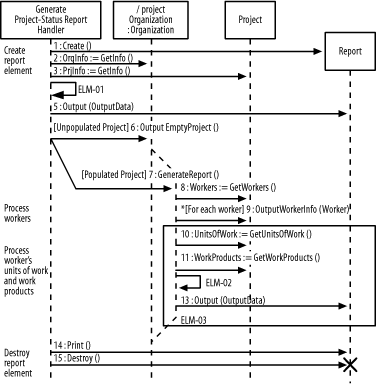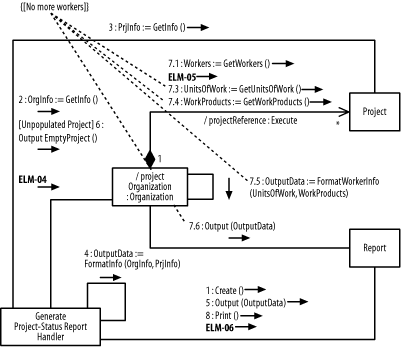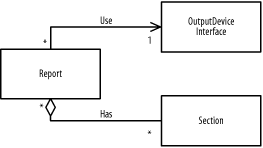6.6 Exercises
Solutions to these exercises are supplied in Section B.2.1
Figure 6-30 shows a sequence diagram, and Figure 6-31 shows a collaboration diagram. These figures are equivalent; that is, they have the same elements. Identify the missing communications and guard expression and describe the interaction and collaboration. The missing communications in Figure 6-30 are labeled ELM-01 and ELM-02. The missing guard expression in Figure 6-30 is labeled ELM-03. The missing communications in Figure 6-31 are labeled ELM-04, ELM-05, and ELM-06.
Figure 6-30. Sequence diagram

Figure 6-31. Collaboration diagram

Describe Figures Figure 6-32 and Figure 6-33: identify the various elements. These elements are used for generating a report and its sections.
Figure 6-32. Sequence diagram for generating a report and its sections

Figure 6-33. Collaboration diagram for generating a report and its sections

Update the diagrams stepwise to show the following interaction and collaboration. After each step, check your answers against the solutions shown in Appendix B:
For each section, the Report element retrieves the section's data using the OutputData := GetData ( ) communication sent to the Section element, and formats the data using the OutputData := FormatData (OutputData) communication sent to itself.
If the section's data is not summary data, the Report element simply outputs the data to the OutputPrinterInterface element using the OutputNonSummaryData (OutputData) communication sent to the OutputPrinterInterface element.
If the section's data is summary data, the Report element simply outputs the data to the OutputPrinterInterface element using the OutputSummaryData (OutputData) communication sent to the OutputPrinterInterface element.







